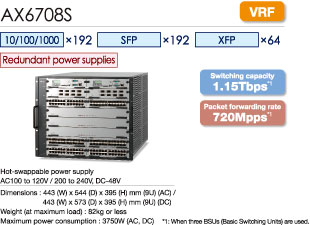
- Overview
- Features
- Models
- Specification
(AX6700S) - Specification
(AX6600S) - Specification
(AX6300S) - Additional
Resources
Layer 3 chassis-type switchesAX6700S/AX6600S/AX6300S Series
The AX6700S/AX6600S/AX6300S Series with fault tolerant architecture that delivers continuous system operation
enhances the reliability of a core switch in enterprise networks.
Various models to meet customers' needs are available, from high performance models
featuring more than 1 terabit switching capacity to cost-effective models.
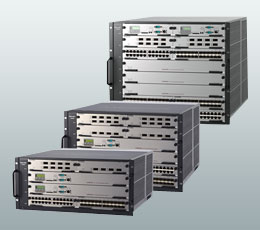
- AX6700S: High performance, feature-rich switches realizing non-stop networks
- Full-spec fault-tolerant switches with an architecture in which the control unit and the packet forwarding unit are installed as an independent module, achieving high availability (easy troubleshooting by localization of a failure)
- 1.15Tbps switching capacity with three Basic Switching Units (BSU)
- AX6600S: Compact, high performance, feature-rich switches
- Compact full-spec fault-tolerant switches integrating the control unit and the packet forwarding unit into one module, while inheriting high availability and power saving technology from the AX6700S
- 384Gbps switching capacity with two Control Switching Units (CSU)
- AX6300S: Cost-effective, standard switches
- Compact, cost-effective, standard fault-tolerant switches deploying the integrated modules with both the control unit and the forwarding unit
- 192Gbps switching capacity
Network Configuration Example
Large-scale Enterprise LAN
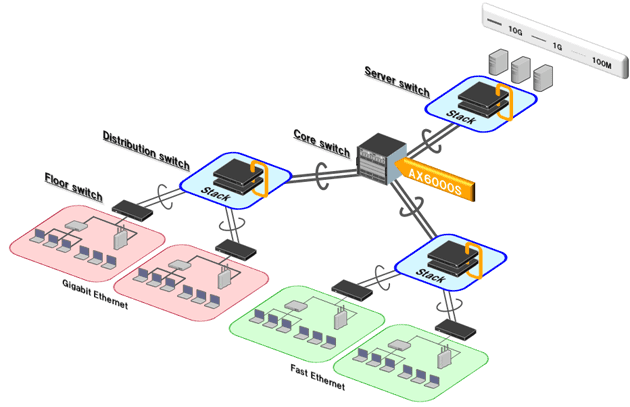

IPv6 Ready Logo
(Logo-ID-:01-000390)
IPv6 Ready Logo Phase2(Core)
(Logo-ID-:02-C-000184)
Fault Tolerant Network
Non-stop network
- STP-free redundancy prevents trouble that is caused due to the complexity of using multiple protocols and provides more stable systems.
Fault tolerant architecture
- Two-in-one architecture integrating two switch units into one provides non-stop system operation.
- FT architecture with carrier-grade availability enables fast switchover.
Virtualization
Simple, low-cost virtual network
- Using VRF (Virtual Routing and Forwarding) and VLAN together enables a network to be divided into logical subnets.
- Virtual network achieves secure and highly reliable networks with lower costs.
VRF
- Multiple independent instances of a routing table in the same switch enable configuration of virtual networks.
Flexible network operation
- Allocating an independent IP address space for each partition allows for flexible network configuration without concern about address overlap.
- Combination of virtualization and triple authentication provides secure login to a virtual network.
High Reliability and High Availability
Ring protocol
- Possible to configure a ring network using the ALAXALA proprietary layer 2 redundancy protocol enabling fast switchover within 1 sec.
- Possible to configure a high-flexibility, multi-ring network.
- A ring network using AX6700S/AX6600S/AX6300S enables switchover with 50 milliseconds (minimum rate).
High reliability
- Improves reliability with link aggregation, STP, VRRP, GSRP(Gigabit Switch Redundancy Protocol), uplink redundancy, graceful restart, UDLD, and EtherOAM.
- Non-stop software update is possible.
Prevention of a loop failure
- Loop detection function prevents loops that may be caused by miscabling.
Storm control
- Storm control prevents the suspension of an entire system when storm has occurred.
QoS
- Granular QoS control enables priority control (for important packets / voice packets), port bandwidth control and so on.
Hierarchical shaper
- Enables traffic control per application on a VLAN, thereby making it possible to achieve stable communication in a wide area network.
- In AX6700S and AX6600S, high-grade features that enable low-latency transmission of high priority packets (for voice, video, etc.) are available.
Hot swappable power supply
- Internally redundant, hot swappable power supplies
Stable High-Functionality Routing
Field-proven routing features
- Routing software equivalent to that of carrier-grade routers that has been well received by many service providers
Policy-based routing
- Makes it possible to select the best route based on each traffic flow.
- Supports a tracking feature, which helps detect communication faults and performs automatic route switchover.
- Usable with VRF.
Policy-based switching
- Supports policy-based switching to choose the best switching path based on traffic flow in layer 2 networks.
IPv6
High performance IPv6 routing
- Hardware-based IPv6 routing as well as IPv4 routing
- Supports various routing protocols, such as static routing, RIPng, OSPFv3, BGP4+, Multicast, and so on.
IPv6 Multicast in layer 2 network
- Supports MLD snooping.
Green IT and Power Saving
Dynamic power saving to cut unnecessary power useAX6700S/AX6600S
- Minimizes power consumption with cutting-edge power saving technologies (power saving mode, cold standby, etc.).
- Dynamic power saving supports the scheduling function that reduces power consumption during the periods of low network usage (e.g., nighttime or holidays) and the traffic-based power saving function that reduces power according to an amount of traffic.
Energy saving design
- Low power consumption with low power architecture / circuit design and energy saving parts
Security
Triple authentication
- Supports three authentication methods (IEEE802.1X, Web, MAC), enabling flexible secure networking.
DHCP Snooping
- Forwards only authorized packets coming from trusted DHCP clients whose IP addresses were issued by DHCP servers.
Quarantine solution
- Only PCs complying with a security policy can access a network.
Filtering
- Supports access control lists for layer 2, layer 3, and layer 4 headers.
VLAN
- Port-based VLAN, Tag-VLAN, protocol VLAN, MAC VLAN
Operation Management and Maintenance
Unified CLI
- Unified Command Line Interface enabling easy operation and maintenance
Command-free maintenance
- Easy maintenance operation (e.g. backup data and update software.) just by inserting an SD card (script) into the switch
- Easy maintenance just by operating a System Operation Panel (SOP) configured of an LCD monitor and operation keys.
AX6700S SeriesDescriptions for the marks
AX6600S SeriesDescriptions for the marks
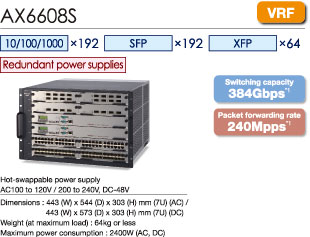 |
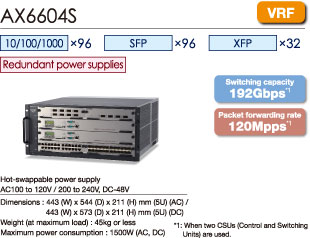 |
AX6300S SeriesDescriptions for the marks
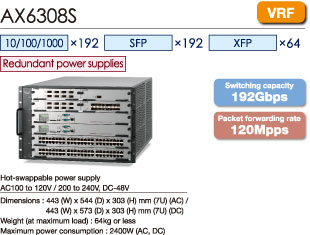 |
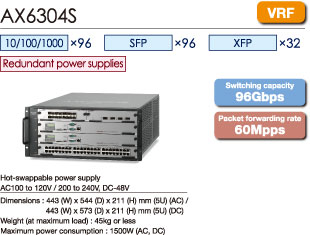 |
Click image for larger view
AX6700S
| Model | AX6708S | |||
|---|---|---|---|---|
| Performance | Switching capacity (Tbit/s) | 1.15 #1 | ||
| Packet forwarding rate (Mpacket/s) | 720 #1 | |||
| Max. ports | 10GBASE-SR/ LR/ER/ZR (XFP) |
64 | ||
| 1000BASE-SX/ SX2/LX/BX/LH (SFP) |
192 | |||
| 10BASE-T/100BASE-TX/1000BASE-T | 192 | |||
| Layer 3 features | IPv4 | Unicast | Static routing, RIP, RIPv2, OSPF, BGP4 #3, IS-IS #2, Policy based routing | |
| Muliticast | PIM-SM, PIM-SSM, IGMPv2/v3 | |||
| IPv6 | Unicast | Static routing, RIPng, OSPFv3, BGP4+ #3, IS-IS #2, Policy based routing | ||
| Muliticast | PIM-SM, PIM-SSM, MLDv1/v2 | |||
| Layer 2 features | MAC entries | 48K
‹ BSU-LA ›
(vlan pattern) 120K ‹ BSU-LB › (vlan pattern) |
||
| VLAN | Port VLAN, Tag-VLAN (IEEE 802.1Q), Protocol VLAN, MAC VLAN, Tag translation | |||
| Spanning tree protocol | STP(IEEE 802.1D), RSTP(IEEE 802.1w), PVST+, MSTP(IEEE 802.1s), BPDU filter, Root guard, Loop guard | |||
| Multicast | IGMPv1/v2/v3 snooping, MLDv1/v2 snooping | |||
| Ring protocol | Autonomous extensible ring protocol | |||
| Others | Policy based switching, L2 loop detection, Storm control, IEEE802.3ah/UDLD, Ether OAM | |||
| Advanced features | Network authentication | Triple authentication (IEEE802.1X, Web, MAC) | ||
| Security | filtering(L2/IPv4/IPv6/L4), Access list logging, DHCP snooping | |||
| QoS | Flow detection(L2, IPv4, IPv6, L4), Bandwidth monitoring(UPC(Policer)), Marking(DSCP, user priority), Priority control(flow-based, DSCP mapping), Discard control, Shaping(port bandwidth control, scheduling(PQ, PQ+RR, PQ+WFQ, PQ+WFQ+BEQ, WFQ+BEQ)), Diff-serv, Hierarchical shaper(port bandwidth control, user bandwidth control, scheduling) |
|||
| High reliability | Load balance(IPv4, IPv6), VRRP(IPv4, IPv6), Static polling(IPv4, IPv6), VRRP polling(IPv4, IPv6), Link aggregation(IEEE802.3ad), GSRP, Fast reroute, Uplink redundancy(receiving), Graceful Restart(BGP4, BGB4+, OSPF, OSPFv3) |
|||
| Virtualization(Network partition) | VRF (Virtual Routing and Forwarding) #3, Forwarding between VRFs | |||
| Others | IPv4 DHCP server/relay agent, IPv6 DHCP server(Prefix delegation)/relay agent #3, L2-VPN(VLAN tunneling) | |||
| Operation management |
Network management | SNMPv1/v2c/v3, MIB-II, IPv6 MIB, RMON, sFlow, LLDP, OADP, CDP, Port mirroring | ||
| Operation / maintenance | CLI, Command-free maintenance(SD card script), RADIUS, TACACS+, SSH #4, uRPF, syslog, ping, traceroute, telnet, ftp, tftp, NTP | |||
| Power saving | Static power saving | Power control of BSU and NIF(restart required), Powering off NIF and ports | ||
| Dynamic power saving | Power control of BSU(restart not required), Powering off BSU, Scheduling | |||
| Redundancy | Power supply, BCU, BSU | |||
| Equipment conditions |
Input voltage | AC 100-120V / 200-240V | DC-48V | |
| Max. input current (A) | 40 @ AC 100V 20 @ AC 200V |
79 @ DC-48V | ||
| Max. power consumption (W) | 3750 | |||
| Max. heat output (kJ/h) | 13500 | |||
| Dimensions W x D x H (mm) | 443 x 544 x 395 (9U) | 443 x 573 x 395 (9U) | ||
| Weight (Kg) (fully loaded) | 82 | |||
| Environmental specifications |
Operating temperature | 0°C to 40°C | ||
| Non-operating temperature | -10°C to 43°C | |||
| Storage temperature | -25°C to 65°C | |||
| Operating relative humidity | 10% to 85% (non-condensing) | |||
| Non-operating humidity | 8% to 85% (non-condensing) | |||
| Storage relative humidity | 5% to 85% (non-condensing) | |||
| Floating dust | Floating dust of about 10 microns or smaller: 0.15mg/m3 | |||
- #1
- When three BSUs are in use.
- #2
- IS-IS is planned to be supported in future.
- #3
- Software option license is required.
- #4
- SSH function is subject to export control regulations, and may be excluded when exported.
AX6600S
| Model | AX6604S | AX6608S | ||||
|---|---|---|---|---|---|---|
| Performance | Switching capacity (Gbit/s) | 192 #1 | 384 #1 | |||
| Packet forwarding rate (Mpacket/s) | 120 #1 | 240 #1 | ||||
| Max. ports | 10GBASE-SR/ LR/ER/ZR (XFP) |
32 | 64 | |||
| 1000BASE-SX/ SX2/LX/BX/LH (SFP) |
96 | 192 | ||||
| 10BASE-T/100BASE-TX/1000BASE-T | 96 | 192 | ||||
| Layer 3 features | IPv4 | Unicast | Static routing, RIP, RIPv2, OSPF, BGP4 #3, IS-IS #2, Policy based routing | |||
| Muliticast | PIM-SM, PIM-SSM, IGMPv2/v3 | |||||
| IPv6 | Unicast | Static routing, RIPng, OSPFv3, BGP4+ #3, IS-IS #2, Policy based routing | ||||
| Muliticast | PIM-SM, PIM-SSM, MLDv1/v2 | |||||
| Layer 2 features | MAC entries | 48K
‹ CSU-1A ›
(vlan pattern) 120K ‹ CSU-1B › (vlan pattern) |
||||
| VLAN | Port VLAN, Tag-VLAN (IEEE 802.1Q), Protocol VLAN, MAC VLAN, Tag translation | |||||
| Spanning tree protocol | STP(IEEE 802.1D), RSTP(IEEE 802.1w), PVST+, MSTP(IEEE 802.1s), BPDU filter, Root guard, Loop guard | |||||
| Multicast | IGMPv1/v2/v3 snooping, MLDv1/v2 snooping | |||||
| Ring protocol | Autonomous extensible ring protocol | |||||
| Others | Policy based switching, L2 loop detection, Storm control, IEEE802.3ah/UDLD, Ether OAM | |||||
| Advanced features | Network authentication | Triple authentication (IEEE802.1X, Web, MAC) | ||||
| Security | Filtering(L2, IPv4, IPv6, L4), Access list logging, DHCP snooping | |||||
| QoS | Flow detection(L2, IPv4, IPv6, L4), Bandwidth monitoring(UPC(Policer)), Marking(DSCP, user priority), Priority control(flow-based, DSCP mapping), Discard control, Shaping(port bandwidth control, scheduling(PQ, PQ+RR, PQ+WFQ, PQ+WFQ+BEQ, WFQ+BEQ)), Diff-serv, Hierarchical shaper(port bandwidth control, user bandwidth control, scheduling) |
|||||
| High reliability | Load balance(IPv4, IPv6), VRRP(IPv4, IPv6), Static polling(IPv4, IPv6), VRRP polling(IPv4, IPv6), Link aggregation(IEEE802.3ad), GSRP, Fast reroute, Uplink redundancy(receiving), Graceful Restart(BGP4, BGB4+, OSPF, OSPFv3) |
|||||
| Virtualization(Network partition) | VRF (Virtual Routing and Forwarding) #3, Forwarding between VRFs | |||||
| Others | IPv4 DHCP server/relay agent, IPv6 DHCP server(Prefix delegation)/relay agent #3, L2-VPN(VLAN tunneling) | |||||
| Operation management |
Network management | SNMPv1/v2c/v3, MIB-II, IPv6 MIB, RMON, sFlow, LLDP, OADP, CDP, Port mirroring | ||||
| Operation / maintenance | CLI, Command-free maintenance(SD card script), RADIUS, TACACS+, SSH #4, uRPF, syslog, ping, traceroute, telnet, ftp, tftp, NTP | |||||
| Power saving | Static power saving | Power control of CSU and NIF(restart required), Powering off NIF and ports | ||||
| Dynamic power saving | Power control of CSU(restart not required), Powering off CSU, Scheduling | |||||
| Redundancy | Power supply, CSU | |||||
| Equipment conditions |
Input voltage | AC 100-120V / 200-240V | DC-48V | AC 100-120V / 200-240V | DC-48V | |
| Max. input current (A) | 16 @ AC 100V 8 @ AC 200V |
32 @ DC-48V | 25 @ AC 100V 12.5 @ AC 200V |
50 @ DC-48V | ||
| Max. power consumption (W) | 1,500 | 2,400 | ||||
| Max. heat output (kJ/h) | 5,400 | 8,640 | ||||
| Dimensions W x D x H (mm) | 443 x 544 x 211 (5U) | 443 x 573 x 211 (5U) | 443 x 544 x 303 (7U) | 443 x 573 x 303 (7U) | ||
| Weight (Kg) (fully loaded) | 45 | 64 | ||||
| Environmental specifications |
Operating temperature | 0°C to 40°C | ||||
| Non-operating temperature | -10°C to 43°C | |||||
| Storage temperature | -25°C to 65°C | |||||
| Operating relative humidity | 10% to 85% (non-condensing) | |||||
| Non-operating humidity | 8% to 85% (non-condensing) | |||||
| Storage relative humidity | 5% to 85% (non-condensing) | |||||
| Floating dust | Floating dust of about 10 microns or smaller: 0.15mg/m3 | |||||
- #1
- When two CSUs are in use.
- #2
- IS-IS is planned to be supported in future.
- #3
- Software option license is required.
- #4
- SSH function is subject to export control regulations, and may be excluded when exported.
AX6300S
| Model | AX6304S | AX6308S | ||||
|---|---|---|---|---|---|---|
| Performance | Switching capacity (Gbit/s) | 96 | 192 | |||
| Packet forwarding rate (Mpacket/s) | 60 | 120 | ||||
| Max. ports | 10GBASE-SR/ LR/ER/ZR (XFP) |
32 | 64 | |||
| 1000BASE-SX/ SX2/LX/BX/LH (SFP) |
96 | 192 | ||||
| 10BASE-T/100BASE-TX/1000BASE-T | 96 | 192 | ||||
| Layer 3 features | IPv4 | Unicast | Static routing, RIP, RIPv2, OSPF, BGP4 #2, IS-IS #1, Policy based routing | |||
| Muliticast | PIM-SM, PIM-SSM, IGMPv2/v3 | |||||
| IPv6 | Unicast | Static routing, RIPng, OSPFv3, BGP4+ #2, IS-IS #1, Policy based routing | ||||
| Muliticast | PIM-SM, PIM-SSM, MLDv1/v2 | |||||
| Layer 2 features | MAC entries | 48K
‹ MSU-1A1 ›
(vlan pattern) 120K ‹ MSU-1B1 › (vlan pattern) |
||||
| VLAN | Port VLAN, Tag-VLAN (IEEE 802.1Q), Protocol VLAN, MAC VLAN, Tag translation | |||||
| Spanning tree protocol | STP(IEEE 802.1D), RSTP(IEEE 802.1w), PVST+, MSTP(IEEE 802.1s), BPDU filter, Root guard, Loop guard | |||||
| Multicast | IGMPv1/v2/v3 snooping, MLDv1/v2 snooping | |||||
| Ring protocol | Autonomous extensible ring protocol | |||||
| Others | Policy based switching, L2 loop detection, Storm control, IEEE802.3ah/UDLD, Ether OAM | |||||
| Advanced features | Network authentication | Triple authentication (IEEE802.1X, Web, MAC) | ||||
| Security | Filtering(L2, IPv4, IPv6, L4), Access list logging, DHCP snooping | |||||
| QoS | Flow detection(L2, IPv4, IPv6, L4), Bandwidth monitoring(UPC(Policer)), Marking(DSCP, user priority), Priority control(flow-based, DSCP mapping), Discard control, Shaping(port bandwidth control, scheduling(PQ, PQ+RR, PQ+WFQ, PQ+WFQ+BEQ, WFQ+BEQ)), Diff-serv, Hierarchical shaper(port bandwidth control, user bandwidth control, scheduling) |
|||||
| High reliability | Load balance(IPv4, IPv6), VRRP(IPv4, IPv6), Static polling(IPv4, IPv6), VRRP polling(IPv4, IPv6), Link aggregation(IEEE802.3ad), GSRP, Fast reroute, Uplink redundancy(receiving), Graceful Restart(BGP4, BGB4+, OSPF, OSPFv3) |
|||||
| Virtualization(Network partition) | VRF (Virtual Routing and Forwarding) #2, Forwarding between VRFs | |||||
| Others | IPv4 DHCP server/relay agent, IPv6 DHCP server(Prefix delegation)/relay agent #2, L2-VPN(VLAN tunneling) | |||||
| Operation management |
Network management | SNMPv1/v2c/v3, MIB-II, IPv6 MIB, RMON, sFlow, LLDP, OADP, CDP, Port mirroring | ||||
| Operation / maintenance | CLI, Command-free maintenance(SD card script), RADIUS, TACACS+, SSH #3, uRPF, syslog, ping, traceroute, telnet, ftp, tftp, NTP | |||||
| Power saving | Static power saving | Power control of MSU and NIF(restart required), Powering off NIF and ports | ||||
| Dynamic power saving | - | |||||
| Redundancy | Power supply, MSU | |||||
| Equipment conditions |
Input voltage | AC 100-120V / 200-240V | DC-48V | AC 100-120V / 200-240V | DC-48V | |
| Max. input current (A) | 16 @ AC 100V 8 @ AC 200V |
32 @ DC-48V | 25 @ AC 100V 12.5 @ AC 200V |
50 @ DC-48V | ||
| Max. power consumption (W) | 1,500 | 2,400 | ||||
| Max. heat output (kJ/h) | 5,400 | 8,640 | ||||
| Dimensions W x D x H (mm) | 443 x 544 x 211 (5U) | 443 x 573 x 211 (5U) | 443 x 544 x 303 (7U) | 443 x 573 x 303 (7U) | ||
| Weight (Kg) (fully loaded) | 45 | 64 | ||||
| Environmental specifications |
Operating temperature | 0°C to 40°C | ||||
| Non-operating temperature | -10°C to 43°C | |||||
| Storage temperature | -25°C to 65°C | |||||
| Operating relative humidity | 10% to 85% (non-condensing) | |||||
| Non-operating humidity | 8% to 85% (non-condensing) | |||||
| Storage relative humidity | 5% to 85% (non-condensing) | |||||
| Floating dust | Floating dust of about 10 microns or smaller: 0.15mg/m3 | |||||
- #1
- IS-IS is planned to be supported in future.
- #2
- Software option license is required.
- #3
- SSH function is subject to export control regulations, and may be excluded when exported.
Related Solutions
Technical Documents
Image archive
- AX6700S (ZIP, 841KB)
- AX6600S (ZIP, 2.42MB)
- AX6300S (ZIP, 2.52MB)


